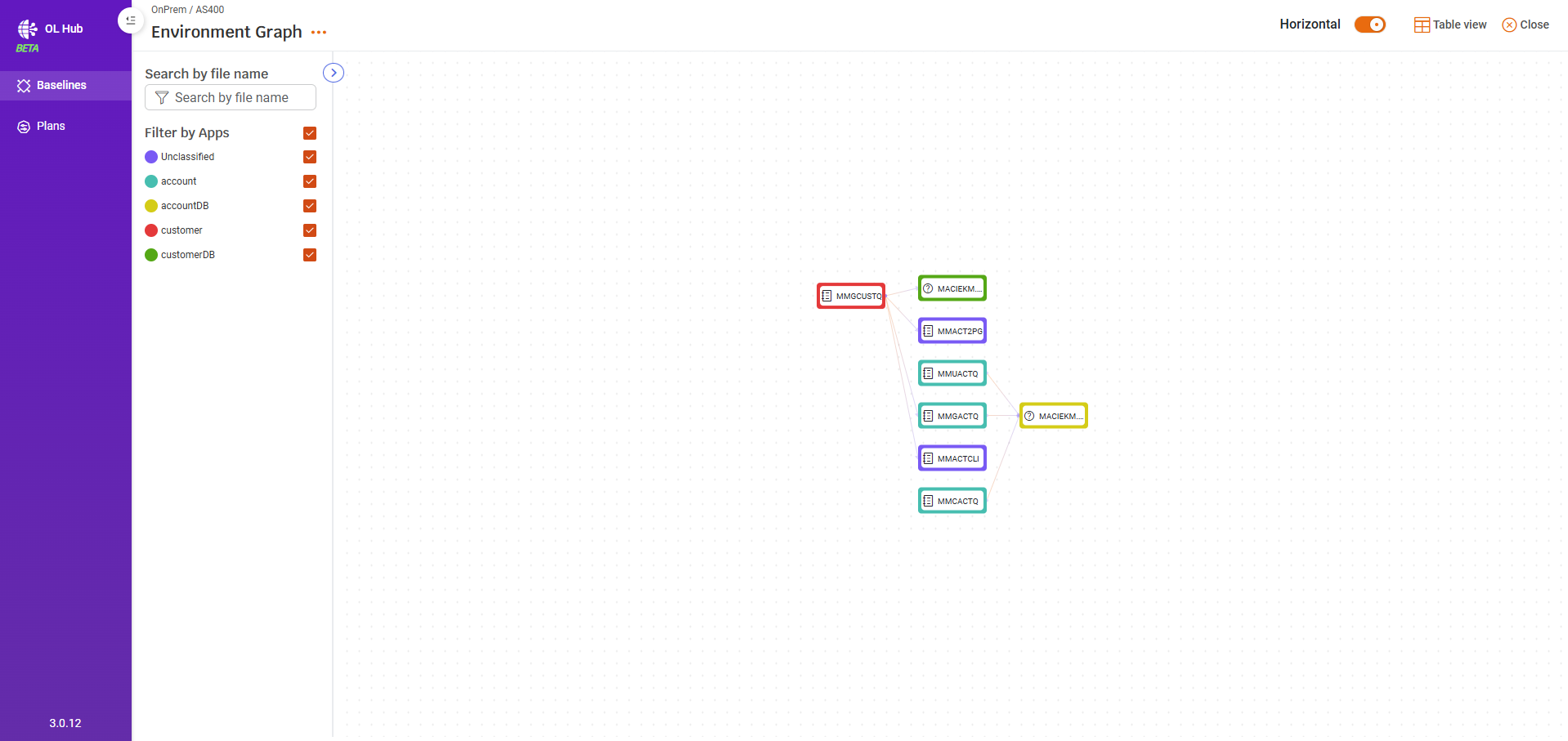Planner Baselines: Your Modernization Landscape
The OpenLegacy Hub Planner is your strategic command center for mainframe and legacy modernization.
It helps you understand your current systems, identify critical dependencies, and build a phased, risk-free roadmap for your transformation. The journey begins with **Baselines **– a dynamic map of your existing modernization landscape.
This article will guide you through creating and working with your first Baseline in the OpenLegacy Hub Planner.
Upon logging into the OpenLegacy Hub, you typically land in the Integration Designer. To access the powerful capabilities of the Planner:
Click the "Your Apps" icon (represented by a globe with three horizontal lines) in the top-left corner of the navigation bar. From the dropdown menu, select "HUB Planner".
You will now be in the Planner interface, ready to begin defining your modernization Baselines.
Understanding Baselines and the Planner Interface
Once in the Planner, you'll notice two main sections in the left-hand navigation menu:
Baselines:
This is where you define and visualize your existing legacy application landscape, including all its interdependencies. Think of a Baseline as a snapshot or a blueprint of your current state.
Plans:
Once a Baseline is established, you can create Modernization Plans, which outline the strategic steps for transforming specific parts of your Baseline.
The Baseline Canvas: Zones, Environments, and Apps
The core of the Baseline creation process happens on the Canvas. Here, you organize your modernization landscape using three key concepts:
Zones:
High-level logical groupings, such as "On-Premise," "Cloud," or "Digital." These help you categorize your systems.
Environments:
Within Zones, you define specific technology environments, like "Mainframe," "Kubernetes," or "Channels."
Apps:
These represent your actual applications, programs, or components within an Environment (e.g., CICS, Accounts, Customers, AccountsApi).
You'll use this visual structure to logically map your existing legacy systems and their future modernized counterparts.

Adding Resources to Your Apps
The next crucial step is populating your Apps with the actual legacy code and metadata – these are your Resources.
The Planner will automatically analyze these resources to understand their dependencies. You have three primary ways to add resources:
Uploading Files: Directly upload your COBOL programs, Copybooks, JCL, or other relevant files from your local machine. The Planner will process them and associate them with the selected App.
Selecting from Existing Hub Resources: If you've previously uploaded resources to the OpenLegacy Hub (e.g., via the Integration Designer), you can select them from a central repository.
Coming Soon - Fetching from Remote Backend (using Legops): For larger, more complex legacy systems, you can leverage Legops to securely connect to your remote backends (e.g., mainframe) and fetch resources directly. This ensures that you're working with the most up-to-date code.
To add resources, select an "App" on the canvas and look for options to add or manage resources associated with it.

Automatic Analysis and Dependency Mapping
Once resources are added to an App, the OpenLegacy Hub Planner springs into action:
Automated Analysis:
The system automatically analyzes the uploaded or fetched resources to identify internal dependencies (e.g., one COBOL program calling another, or a program accessing a specific file).
Related App Creation:
Based on identified dependencies, the system may automatically create new "related Apps." For instance, if a COBOL program accesses a VSAM file, the Planner might automatically create a "VSAM Data App" to represent that data dependency. This helps ensure a complete and accurate representation of your landscape.
Dependency Graphs and Lists:
The Planner visualizes these dependencies, providing invaluable insights:
App Dependency Graph:
This graph clearly shows the connections and calls between different applications, highlighting which components rely on others. This is essential for identifying safe "decoupling points" for modernization.
Environment Dependency Graph: You can also trigger a view that shows dependencies across different environments, giving you a broader understanding of your system's interconnectedness.

Dependency List (Table): Alongside the visual graphs, a tabular list provides detailed information about each dependency, including the source, target, and type of interaction.
These visualizations are critical for planning a strategic and risk-free modernization path.
Managing Links Between Apps
While the Planner automatically draws many links based on resource analysis, you also have the flexibility to:
View Auto-Generated Links:
Observe the connections the system has identified between your Apps.
Add Other Links:
Manually add logical links between Apps that might not be directly discoverable through code analysis but represent important architectural or business dependencies. This allows you to refine the Baseline to accurately reflect your system's reality.
Modify Links:
Adjust or remove existing links as your understanding of the system evolves.
When Your Baseline is Ready: Creating Your First Plan
Once you have meticulously mapped your legacy landscape, added relevant resources, and confirmed the dependencies within your Baseline, you are ready for the next phase: creating a Modernization Plan.
A completed Baseline provides the foundational knowledge required to design a phased and strategic approach to modernizing your applications.
Updated 19 days ago
Deep Dive into Resources: Learn more about the different types of resources you can add and their impact on dependency analysis.
Building Your First Plan: Proceed to the "Creating Modernization Plans" article to begin defining your modernization strategy.